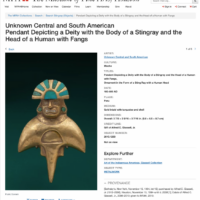Sold at Sotheby’s in 1994, this object was claimed by Peru but didn’t go back. Now it is in Texas.
The nice thing about having a blog is that you can externalise your own memory. Although I don’t do this as much any more, since this blog came into existence in 2011, I’ve used it to tuck away little observations which I usually come back to (years) later. One can never tell what will be interesting in the future.
A couple weeks ago I was working on identifying some objects indirectly for an official agency. This brought me to some comparable objects within the collection of The Museum of Fine Arts, Houston (MFAH), part of a massive collection of Latin American antiquities bequeathed by Alfred C. Glassell, Jr. Great, that’s exactly what I needed.
Thing is, the MFAH collections website has a feature at the bottom of every object page that is titled “Discover More”. It presents a spread of 12 images of other objects in the museum collection that are related to the first object in some way. In the “discover more” on one page I was looking at, I noticed a Peruvian gold object that seemed familiar. “HUH!” I said. I clicked on it.
Let’s roll back in time for a moment
In 1987 the spectacular Moche site of Sipán, Peru was famously looted. Items from Sipán made it to the USA and the rest of the world in a variety of documented ways. At various times Peru sought to have Sipán objects returned, sometimes unsuccessfully, sometimes successfully. One successful return occurred in 1996, after objects from Sipán appeared for sale at Sotheby’s New York (see full case here).
There was one thing that always confused me about this return case, one aspect of it that I never figured out. Peru initially requested the seizure and return of five items:
- Lot number 7 was listed as a ‘Late Chavin Gold Head Bead’, dated to ‘700–400 B.C.’ and valued at ‘$4,000–6,000’ (Sotheby’s Auction House 1994). The piece did not sell at the 15 November auction.
- Lot number 10 was listed as an ‘Early Mochica Gold and Turquoise Effigy Ear Ornament’ dated to ‘300–100 B.C.’ and valued at ‘$20,000–30,000’ (Sotheby’s Auction House 1994). The piece did not sell at the 15 November auction.
- Lot number 11 was listed as a ‘Late Chavin Gold and Turquoise Necklace’, dated to ‘700–400 B.C.’ and valued at ‘$5,000-7,000’ (Sotheby’s Auction House 1994). The piece sold for $5,750 at the 15 November auction.
- Lot number 17 was listed as an ‘Early Mochica Turquoise and Gold Necklace’, dated to ‘300–100 B.C.’ and valued at ‘$1,200–1,800’ (Sotheby’s Auction House 1994). This piece sold for $6,325 at the 15 November auction.
- Lot number 18 was listed as an ‘Early Mochica Gold Ornament’, dated to ‘300–100 B.C.’ and valued at ‘$1,200–1,800’ (Sotheby’s Auction House 1994). This piece sold for $2,185 at the 15 November auction.
Lots 7, 11, and 17 were returned to Peru. Lots 10 and 18 were given back to Sotheby’s. I never found out why, but the following possibilities have always been in my head:
- Lots 7, 11, and 17 were consigned by dealer David Bernstein, a man who had a prior conviction for filing false customs declarations related to Peruvian antiquities. Perhaps lots 10 and 18 were consigned by someone else so had a different past and trajectory?
- Lots 10 and 18 were seized with the other, but perhaps when they were inspected by Peru’s experts they were found to be fakes.
- Perhaps Peru’s experts felt Lots 10 and 18 were truly not from Sipán, but that seems unlikely.
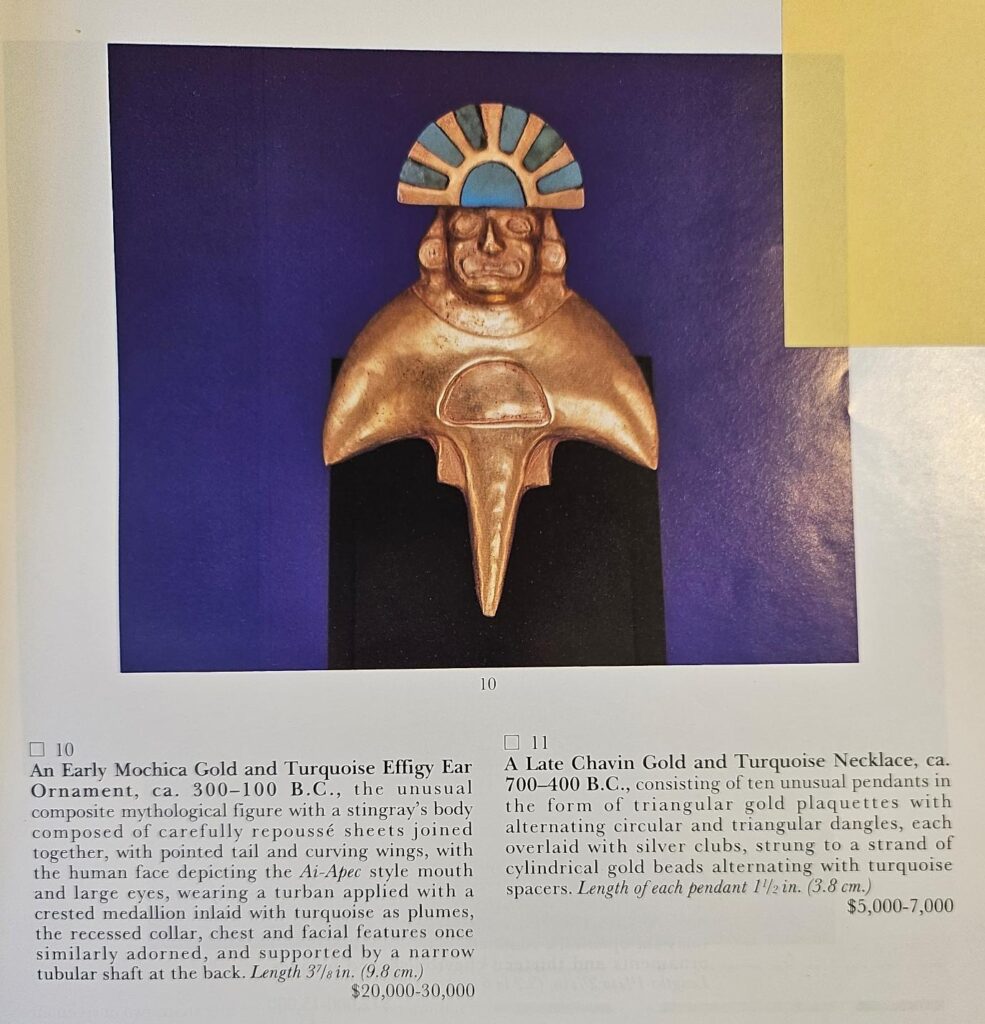
Reappearance in Houston
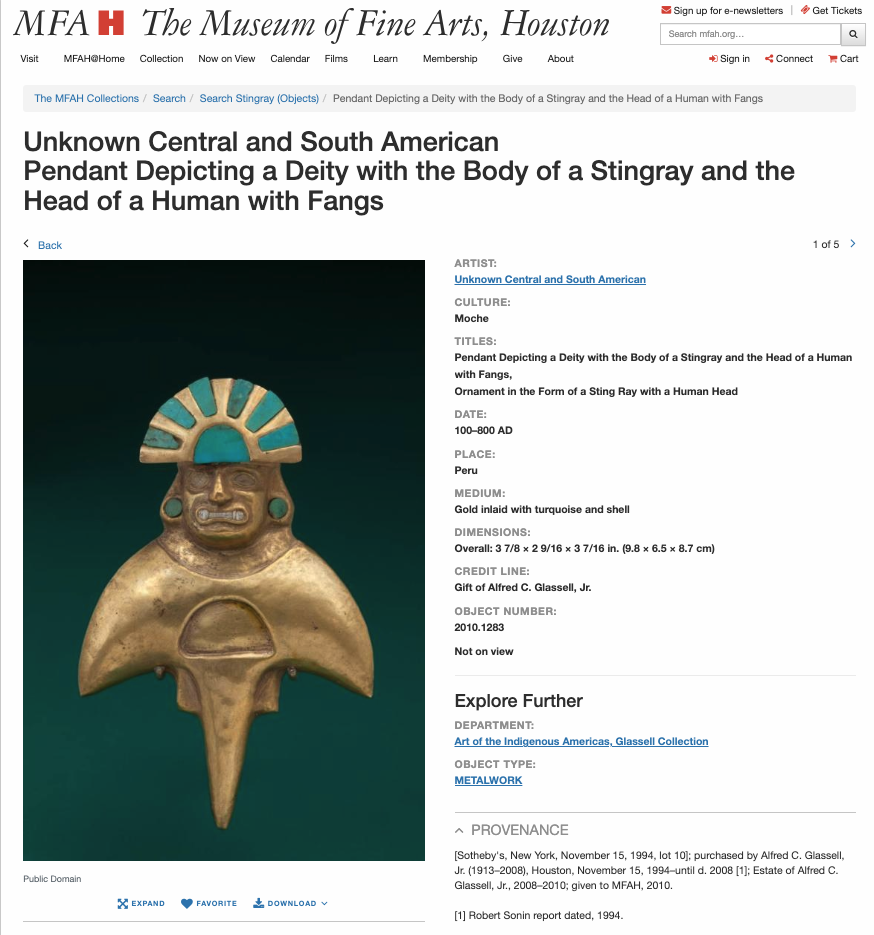
But that was the end of the story. Lots 10 and 18 disappeared and I hadn’t heard about them again. That is until I saw lot 10 as a “Discover More” on the MFAH website.
Listed as “Unknown Central and South American Pendant Depicting a Deity with the Body of a Stingray and the Head of a Human with Fangs” on the museum website, it is clearly the same object. However there have been some…changes. Between the object’s depiction in the 1994 Sotheby’s catalogue and when it was photographed by the MFAH, the object appears to have “grown” both some inlaid teeth and some inlaid ear spools. I wonder who made those. Also, a few of the inlaid headpiece bits have been moved around. The provenance of the piece is listed as:
[Sotheby’s, New York, November 15, 1994, lot 10]; purchased by Alfred C. Glassell, Jr. (1913–2008), Houston, November 15, 1994–until d. 2008 [1]; Estate of Alfred C. Glassell, Jr., 2008–2010; given to MFAH, 2010.
Sotheby’s 1994
What I don’t see in the MFAH is lot 18, a gold feline thing. Either Glassell wasn’t the buyer of that one, or he bought it and did something else with it other than bequeath it to the MFAH.
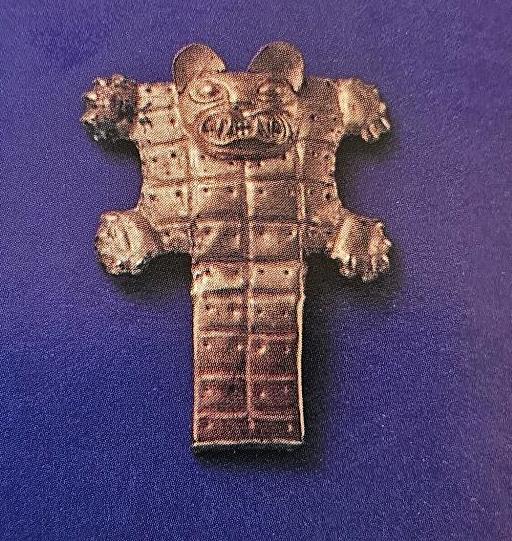
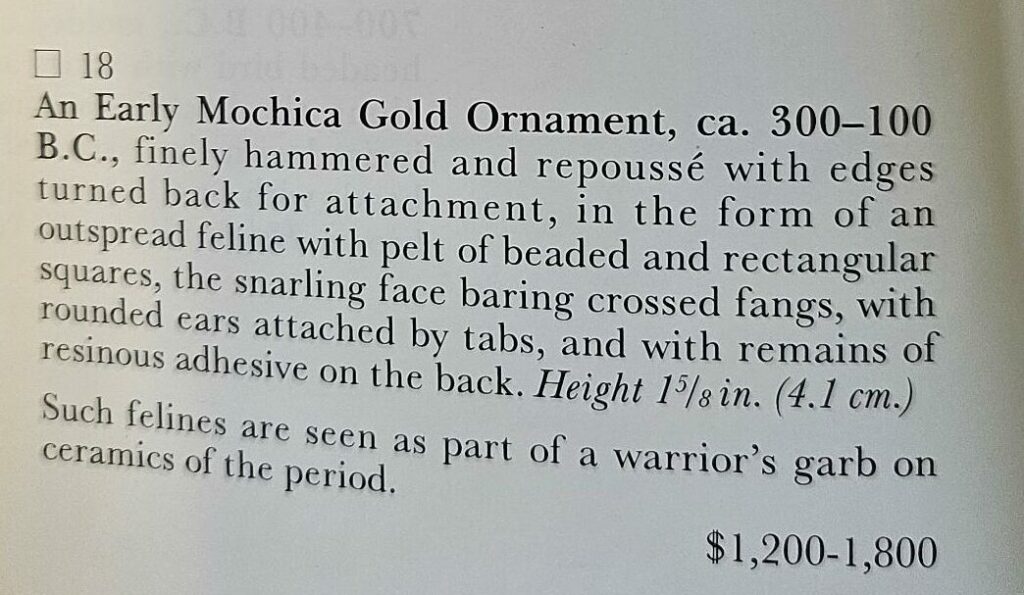
Coming back around (not often)
Ages ago, in 2005/06, I documented all South American antiquities sold at Sotheby’s New York for a certain span of time as part of my master’s dissertation. I looked at a lot of South American antiquities. It is rare for me to ever come across them again. It happens from time to time, but most of them seem to just drift off into the void, never to be seen again. Lot 10, there, has emerged from the void, but that is the exception, not the rule.
I still don’t know why lot 10 (and 18) were not returned to Peru, and I am going to email the MFAH to see if they will share anything about it that might be in their records, although I doubt they will have anything. But the object’s presence in the Glassell collection, how how it looks today, makes one of my bullet points above seem perhaps more likely: that the piece isn’t authentically ancient.
Why? Because I don’t like the looks of a lot of the objects that Glassell bequeathed to the MFAH. Many of them look flat out fake. I won’t say which, I won’t say why, and I could certainly be wrong, but there are iconographic and construction problems with a lot of these items. I’ve also heard through the grapevine that Glassell may have been a vacuum of a collector (my words), just sucking up whatever. Finally, lot 10 grew teeth and ear spools that it didn’t have when it was offered at Sotheby’s: whoever was interacting with the piece considered it to be modifiable.
That’s it. I’m just going to but this here in case I need it later or if anyone else has something to add. Let me know if you know where Lot 18 is, if you know exactly why Peru didn’t end up with those two lots, or if you want to tell me more about Glassell and his purchasing habits. I’ll listen!
